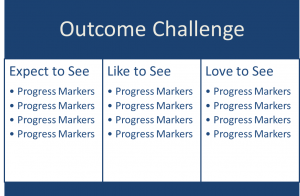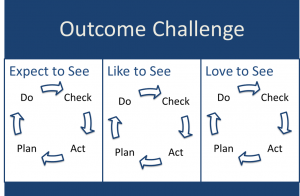I use to believe that marketing funnels, value stream maps, process mapping and to some extent customer journey maps would work in present day sales and marketing processes (Value Stream Mapping should be left on the Shop Floor). I am not saying they won’t, but I have taken a completely different approach over the past year and have moved more and more towards an outcome-based mapping approach, often depicted as a Program Logic Model. The best map I have found is depicted below and created by the University of Wisconsin Extension. At their site, you can download the model both in PDF and Excel and access an excellent teaching and training guide.
The outcome-based modeling concept fits my Lean mentality extremely well. It serves as a great platform for moving Lean from the supply sided (internal) thinking to the demand (external) thinking. Further expansion of these ideas are encapsulated in my blog post, Mapping Expectations of Customer Behavior.
One of the specific parts of the outcome-based mapping are the Progress Markers. These markers are the specific behavioral changes that are required of the boundary partners. They call this process the “outcome challenge.” Outcome challenges are often described similar to user stores. An example: The (project) intends to see (partner) who (describe behavior). I have seen several ways to extend this wording by using markers such as behaviors (expect-to-see, like-to-see and love-to-see) and in duration (short, medium, long). 
The strength in this process is that you look for changes in behaviors versus trying to move a customer/prospect down a path. When you view your customers/prospects in a linear path, it becomes a manipulative path towards a transactional event. If we view the process as a set of outcomes, we work towards understanding and agreement.
In the Logic diagram above, it depicts short, medium, and long term outcomes. In outcome-based mapping, we use the terminology expect-to-see, like-to-see and love-to-see. In each of these columns, we list progress markers that demonstrate positive movement towards changes of behaviors, actions, activities or relationships of our customers. These changes allow us to support our partner towards a more meaningful outcomes while empowering a more cooperative relationship.

I use the tools of Lean within the columns not to guide but to learn and improve our knowledge of the progress markers.
It is the behavior that will lead to a positive outcome. In a Lean sense, we will apply the principles of Cap-Do, PDCA, SDCA within these columns to make the appropriate changes if needed. It resembles somewhat a Hoshin Kanri or Kata approach to our process.
Transactional type thinking of manipulation, features, benefits and closing sales are fading away. What is coming to the forefront is a world of understanding and gaining agreement in a cooperative way. Outcome-Based mapping is an unique tool that can help us move in this direction.
Book reference: Outcome Mapping: Building Learning and Reflection into Development Programs
Lean Sales and Marketing: Learn about using CAP-Do


Comments are closed.